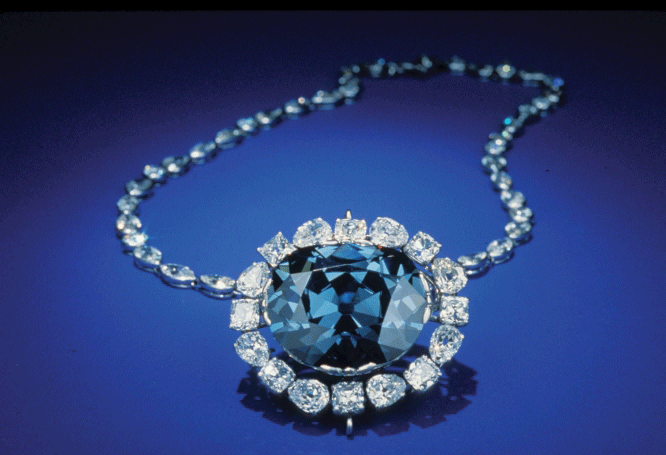Curse of the Hope Diamond

The Hope Diamond is the most famous diamond in the world. It now resides in the Smithsonian Institute in Washington D.C., in the National Gem Collection.
Many people know that it has a famous curse attached to it, but what are the details of the curse, and why is it in a museum in the United States today? The story has more twists and turns than a winding road.
The curse of the diamond begins with its theft. In the mid-1600s, a French diamond merchant named Jean Baptiste Tavernier was traveling in India in search of treasure.
He was said to have removed the large diamond, which was around 112 carats at the time, from the eye of an ancient statue.
When the priest guarding the statue found out it was missing, he cursed all that would own or wear the diamond as punishment for the removal of a spiritual, mystical implement. Tavernier sold the rare, giant blue diamond to King Louis XIV of France in 1668. Soon afterward, the story of the curse says that Tavernier, on one of his exotic trips, was torn apart limb from limb by a pack of wild dogs. He is said to be the first victim of the curse.
Louis XIV took the large blue diamond and had it cut into a smaller diamond of 67 carats. It became known as the Blue Diamond of the Crown, or the French Blue and was worn during special state occasions.
Some say Louis was touched by the curse, for he died of gangrene and all of his children died in childhood, except for one.
The famous diamond was passed down as part of the French crown jewels to Louis XV, then Louis XVI. It was rumored that Marie Antoinette, famous Queen of France and wife of Louis XVI, wore the diamond as well, ultimately succumbing to the curse by way of the French Revolution and beheading at the guillotine.
During the French Revolution, the Hope Diamond was stolen when it was put in a locked house for safe keeping. Napoleon even tried to find it, but he could never recover many of the prizes taken during these dark days in France. It reappears 20 years later in London, in the possession of an English diamond merchant by the name of Daniel Eliason. It is smaller now, with a weight of 45.52 carats.
Eliason sold the Hope Diamond to King George IV of England in 1812. George considered it a prize for defeating Napoleon. Some say the curse touched George, who nearly bankrupted the throne of England during his reign, and died with a heavy burden of debt. When he died, his executor, the Duke of Wellington, sold the diamond to pay off debts, and Henry Philip Hope, from which the diamond gets its modern name, purchased the rarity.
Hope’s family was extremely wealthy. They had vast land holdings and acquisitions of many prizes, including rare paintings and other jewels. In 1887, the diamond was inherited by family member Lord Francis Hope. He began to see the effects of the alleged curse, and began to have defunct business deals, bad horse betting, marriage woes, and ultimately an ugly divorce that found him having to sell the diamond to a New York jeweler, Joseph Frankel.
Frankel had been a successful jeweler in the Big Apple, but some say the diamond changed all of that. He put much of his business capital into buying the diamond, and with the recession of 1907, he lost most of his cash, and his business because of this purchase. He had to sell the diamond and ultimately went completely bankrupt. This story made it into the New York Times in the financial pages, with an attachment of bad luck to the diamond, and a curse is born in the public eye. The story was picked up by other newspapers as a fascination piece, where it reached Washington and even London with tales of Marie Antoinette and Louis XVI, bankruptcies, curses and more.
The diamond was sold to the Cartier brothers in Paris, who in turn, sold it to Washington D.C. socialite Evalyn Walsh McLean in 1912. McLean was part of a powerful family in America’s Guilded Age, and she loved the story of the curse.
She said cursed things brought her good luck, and she would wear the diamond at lavish parties and display her prize. She wore the diamond often, around her neck on a chain. Some say she became obsessed with the Hope Diamond.
The curse, if you believe in such things, hit her the hardest. Her 10-year-old son was struck by a car, her husband became insane, and her daughter committed suicide. In 1947, after her death, the diamond was sold to a jeweler, Harry Winston.
Winston donated, after much convincing, the famous diamond to the Smithsonian Museum in Washington. It was mailed in a plain brown paper-covered box, with insurance, to the Smithsonian, through regular U.S. Postal Service.
It is on permanent display in the museum behind a rotating glass case, and is one of the most visited and photographed items in the world. It is now part of the collection of the United States, and owned by the American people.
(Editor’s note: DeeDee Wood is the store manager at Tharpe Antiques, inEaston, part of the Talbot Historical Society.)



